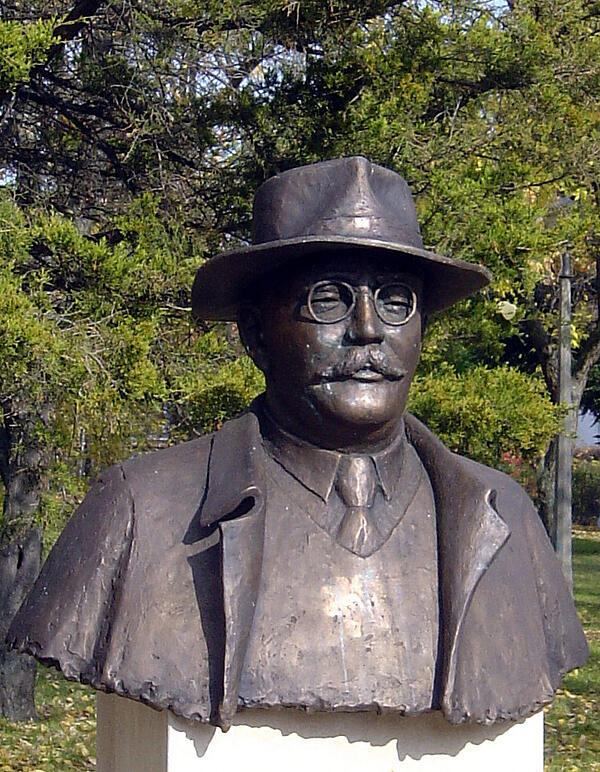Imre Nagy
Imre Nagy was a Hungarian politician who played an important role in the Hungarian Uprising. After the Soviet crushed the rebellion, Nagy was executed and his body was buried in an unmarked grave, but was formally re-buried in 1998 at a funeral attended by over 100,000 people.
Born on 7 June 1896, Imre Nagy grew up in Kaposvár, Southern Hungary. During World War One, Nagi fought for Austria-Hungary but was captured in 1915 on the Eastern Front. Following his escape from prison he joined the Russian Communist Party and fought on the side of the Red Army.
By the time Nagy returned to Hungary he was a committed, but secret, communist. After the collapse of the Hungarian Soviet Republic in November 1919, communists were forced underground in Hungary. For his own safety, in 1928 Nagy left Hungary and moved to Austria.
Between 1930 and 1944, Nagy studied agriculture in the Soviet Union - an education that he would later put to use during his time as the Minister of Agriculture in Hungary.

By the time that Second World War had drawn to a close, the Soviet Union’s Red Army controlled much of Eastern Europe. When the Red Army liberated Hungary from the German Army, Nagy returned to Budapest and served as Minister of Agriculture in the provisional government established in 1945. In this post he introduced important land reforms based on the idea of collectivisation. This required land estates to be broken up and turned into the property of the people.
In July 1953, four months after Stalin’s death and with the Soviet Union’s approval, Nagy was appointed prime minister, replacing the unpopular and ruthless, Mátyás Rákosi. As soon as he came power he brought in more liberal policies, including relaxing some of the strict rules on collectivisation and encouraging the manufacture of consumer goods.
But in April 1955, Moscow forced Nagy to resign as they felt his more liberal regime might encourage other countries in the Eastern Bloc to rebel. He was expelled from the Communist Party in November 1955 and effectively cast into the political wilderness. His predecessor Mátyás Rákosi - a ruthless and unpopular leader - once again led the country.
The Hungarian Uprising began in October 1956. A group of revolutionary Hungarian students created a list of demands (the ‘sixteen points’). One of these demands was for for a new government under the leadership of Imre Nagy. Nagy formed a government on 26 October. The coalition government included three non-communists from the Petofi Peasants Party, the Smallholders Party and the Social Democratic Party.
Nagy’s main promise was to improve the standard of living of the Hungarian workers. He planned to achieve this by introducing “far reaching democracy” into Hungarian daily life, and a distinct form of socialism.
From Moscow’s point of view, Nagy seriously overstepped the mark when he announced on 1 November that Hungary would leave the Warsaw Pact and become a neutral nation. If this went unchecked, other Soviet satellites might follow suit and the Warsaw Pact would collapse. Moscow could not tolerate this. On 4 November, Soviet troops invaded Budapest and other rebelling areas. By 10 November, the Uprising had been crushed. Nagy took refuge in the Yugoslav embassy.
Nagy was coaxed out of the embassy on 22 November by a message from János Kádár, which promised him safe passage. In fact, Nagy was arrested when he left the embassy. He was sent to Romania, before returning to Hungary in 1958 to face trial. Nagy was tried secretly and sentenced to death in June 1958 for treason and attempting to ‘overthrow the democratic state order’.
Nagy was hanged on 17 June 1958. News of his trial only reached the public after his execution. Nagy was buried in the prison yard where he was executed. Later he was moved to the New Public Cemetery, Budapest, where he was buried face down.
In 1989, 31 years after his execution, Imre Nagy was disinterred and given a public funeral. An estimated 100,000 people attended his re-internment.
See also: Hungarian Secret Police
MLA Citation/Reference
"Imre Nagy". HistoryLearning.com. 2025. Web.
Key facts
| Name: | Imre Nagy |
| Birth Date: | 7 June 1896, Kaposvár, Austria- Hungary |
| Death: | 16 June 1958 (aged 62), Budapest, People's Republic of Hungary |
| Spouse: | Mária Égető |
| Political affiliations: |
Hungarian Communist Party
Hungarian Working People's Party |
| Political appointments | Chairman of the Council of Ministers of the People’s Republic of Hungary
|
